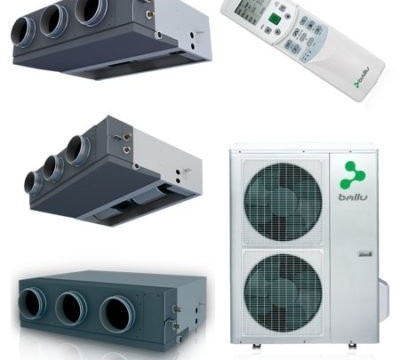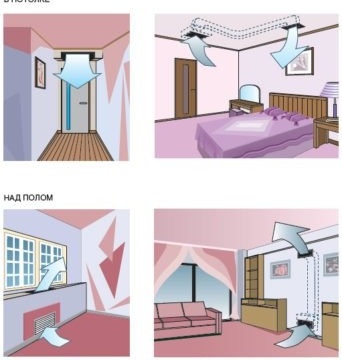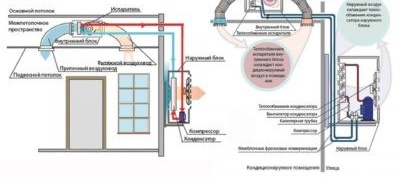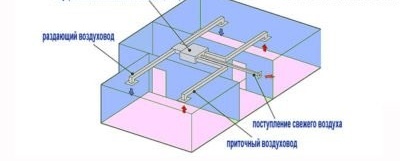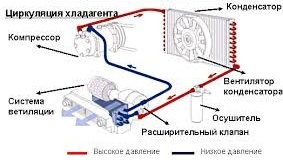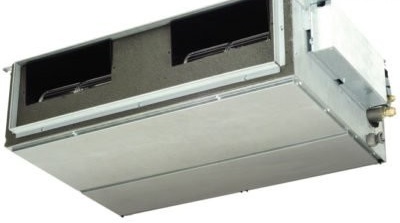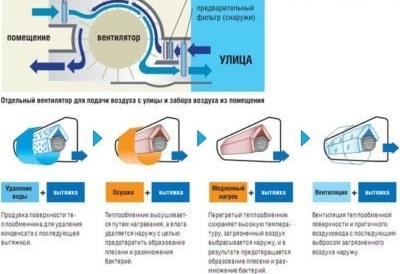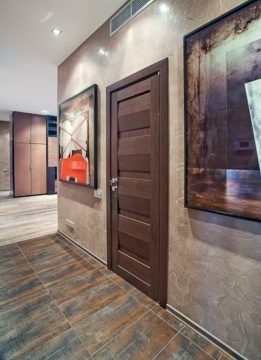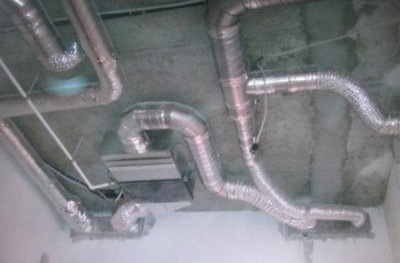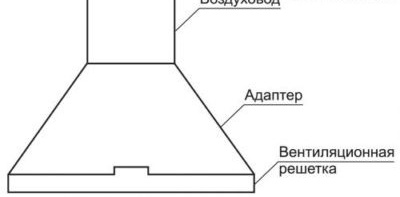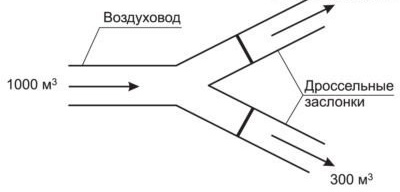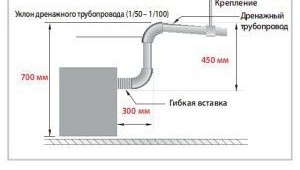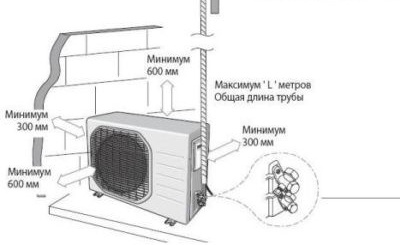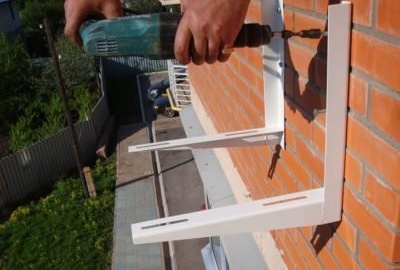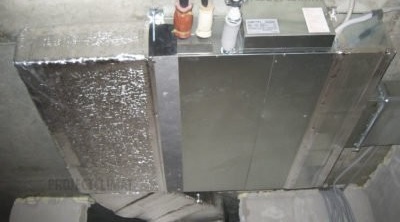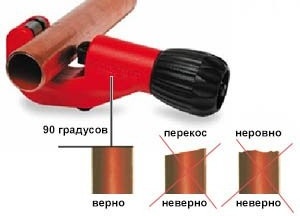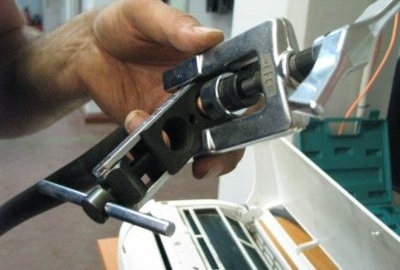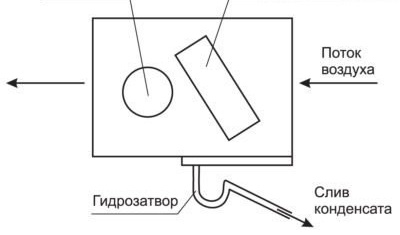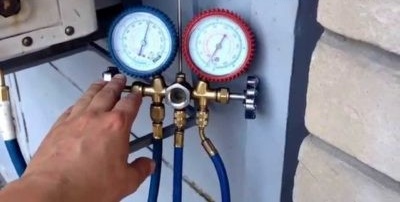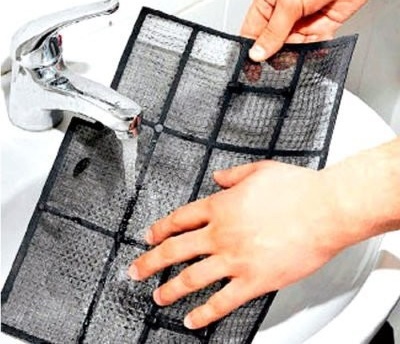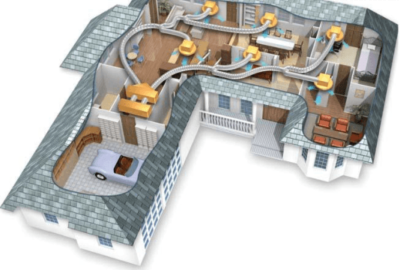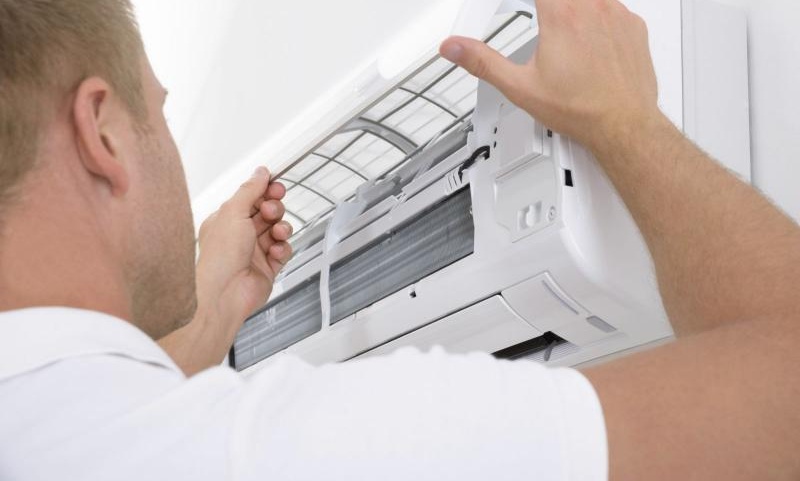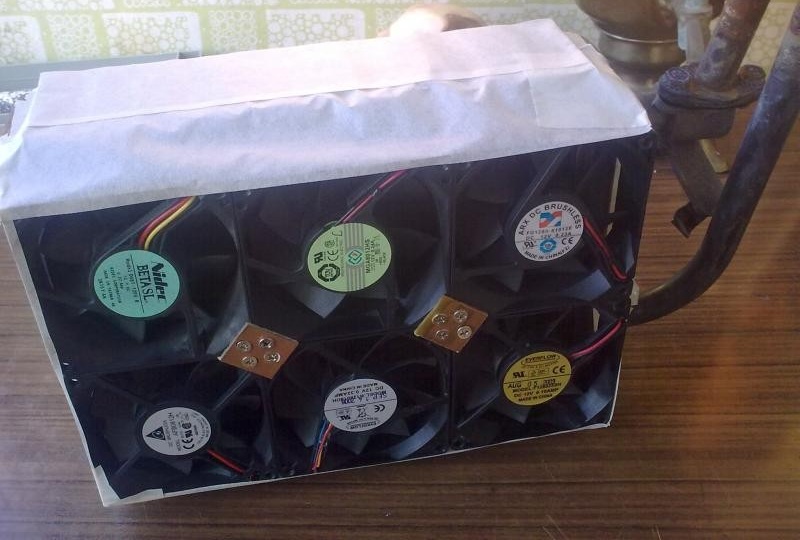Duct air conditioning: what it is, how to carry out its installation
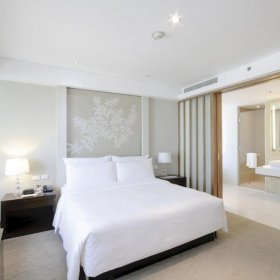
Duct air conditioners are not as widespread as ordinary wall air conditioners, and many ordinary people simply do not have the slightest idea about them. Meanwhile, to some of the potential buyers such a device would seem most suitable. We offer the reader to get acquainted with this kind of climatic equipment and the features of its installation.
Content
What is a channel air conditioner, its purpose and design features
The channel air conditioner is designed to distribute chilled air through a duct network. It can be used to service several rooms or evenly cool one room with a large area or complex configuration (for example, U-shaped). Heated air from the service area is also supplied to the air conditioner through the ducts.
All channel air conditioners are split-systems, that is, they consist of outdoor (fixed on the street) and indoor (located in the room) units connected by freon-conduits and electric cables. The indoor unit, unlike the wall model, has the simplest design: in a living room or office, the air ducts in any case have to be hidden using a false ceiling, so that the air conditioner itself will not be visible.
In production facilities, the appearance of the equipment does not attach much importance. Usually it is a kind of box on which there are intake and discharge openings (air ducts are connected to them), as well as fittings for connecting the freon conduits and the condensate removal system.
Inside the box there is everything the same as in any other split system:
- heat exchanger;
- fan;
- electronic control board;
- condensate drain pan.
Cooling large volumes of air is accompanied by the formation of a significant amount of condensate, so some models have a built-in pump to remove it - it is called a drain.
Another difference from the wall model is the use of a more powerful fan in the indoor unit. This is due to the need to force air through long ducts with high aerodynamic drag.
Operating principle
The channel air conditioner works in exactly the same way as any other.The basis of the device is a heat pump. It consists of a closed loop filled with special gas (refrigerant) (two radiators connected by tubes) and a compressor that makes this gas move in a circle.
"Pumping" of heat is carried out due to alternate compression and expansion of the refrigerant. The compression takes place in the external radiator of the circuit, while the gas temperature rises significantly, so that it becomes hot. Due to the temperature difference, heat exchange begins between it and the outside air, during which the refrigerant gives off thermal energy received from the air in the room. To make heat transfer more intense, an external radiator is blown by a fan.
The increase in pressure in the external radiator is due to the installation at its outlet of a certain device - a throttle that allows gas to pass in very small quantities. Thus, the refrigerant pumped by the compressor accumulates in front of the throttle and is strongly compressed. The simplest version of the throttle is a long thin tube (capillary).
The compression pressure is selected so that the gas condenses during cooling, that is, it turns into a liquid. The fact is that during condensation the gas generates much more heat than just when it cools, therefore the efficiency of the heat pump increases significantly under this mode. Because of this process, the outdoor heat exchanger is called a condenser.
Through the choke, liquid refrigerant gradually seeps into the internal radiator located in the room (in the indoor unit). The pressure here is low, so the liquid evaporates, turning back into gas. The internal radiator, respectively, is called the evaporator.
It turns out that a small amount of gas occupies the entire volume of the internal radiator, that is, it expands. Because of this, the refrigerant cools down very much and begins to heat up from the internal air (there is also a blower here). Having absorbed a certain amount of heat, the gas enters the compressor, which pumps it into the external radiator, and the entire cycle is repeated.
For the most part, modern air conditioners are designed so that it is possible to redirect refrigerant flows and thereby turn the external radiator from a condenser to an evaporator, and the internal one from an evaporator to a condenser. In this case, the heat pump will begin to “pump” heat in the opposite direction, that is, the air conditioner will work in heating mode.
Note that the heat delivered to them will be, so to speak, gratuitous, that is, the user will bask, paradoxically as it sounds, from the cold street air. Of course, for this you will have to spend a certain amount of electricity (compressor operation), but in a ratio of not 1: 1, as in the case of electric heating elements, but about 1: 4. That is, for each 1 kW of electricity consumed, the user will receive about 4 kW of heat.
It is clear that with a decrease in the outside temperature this ratio will be less and less profitable until at a certain moment the efficiency of the air conditioner is completely zero. Therefore, to operate this device in heating mode makes sense only at those outdoor temperatures that are recommended by the manufacturer.
Kinds
Duct air conditioners are divided into several varieties according to the following characteristics:
By the pressure of the fan of the indoor unit
Pressure is pressure; accordingly, it is measured in Pascals (Pa). Air conditioners are:
- low pressure, with a pressure up to 50 Pa;
- medium pressure, with a pressure up to 150 Pa;
- high-pressure, with a pressure up to 300 Pa.
The higher the aerodynamic resistance of the air ducts connected to the air conditioner, the higher the pressure required to force air through them.
By operation mode (type of electrical circuit)
There are two options:
- Start / stop air conditioners: in these devices, the compressor always runs at the same speed, respectively, and the power of the heat pump remains almost constant. To maintain the temperature at a level set by the user, the automation periodically turns off the cooler, which is why this mode is called “start / stop”.
- Inverter: more modern air conditioners, in the electrical circuit of which there is an inverter - an electronic device that allows you to receive alternating current of any frequency. This makes it possible to control the speed of the compressor and, accordingly, the power of the heat pump.
The inverter air conditioner does not turn off - it sets the optimum cooling power and works continuously in this mode.
You should be aware that sellers often attribute to inverter air conditioners advantages that do not actually exist. The desire to increase demand for these models is quite understandable: an inverter cooler costs 1.5–2 times more expensive than a regular start / stop air conditioner of the same power.
Here are the most common myths:
- Inverter air conditioner saves energy: at the same time breathtaking numbers are reported - up to 30%. However, any attempts to find information about where, by whom, and under what conditions the studies were conducted, are unsuccessful. If we argue theoretically, then the inverter model may be even more costly: it has an additional consumer in the person of the inverter control board plus some losses are characteristic of its power circuit.
- A shutdown mode extends the life of the compressor: in response to such a statement, experienced craftsmen advise recalling the compressors of Soviet refrigerators that have been operating in the "start / stop" mode for decades and have not broken. The same can be said about the compressors of the first imported air conditioners that appeared in the USSR in the 80s. They regularly served for a very long time, until the device was changed due to moral aging or loss of attractive appearance. Thus, we can conclude: the compressor is a very tenacious unit, even if it works in the "start-stop" mode.
- The inverter air conditioner is less noisy: the compressor in the split system is specially placed in the outdoor unit so that it cannot be heard in the room, so its operation mode does not affect the internal noise background. The “sound accompaniment” is produced by the fan of the indoor unit and the moving air flow, on which the inverter does not exert the slightest influence.
The only real advantage of inverter air conditioners is that they maintain a stable temperature (in the "start-stop" mode, it constantly fluctuates within 3 degrees), and most importantly - they supply less cold air. The latter circumstance reduces the likelihood of a cold, which is especially true during sleep, when a person is most vulnerable.
However, one has to admit that over time, inverter air conditioners become more and more not of direct, but, so to speak, indirect advantages. The fact is that manufacturers rely on this particular type of cooler, as the most advanced. Therefore, all the most modern developments, for example, the latest economical compressors, are used primarily in them. It can be expected that soon the release of start / stop air conditioners will completely cease.
By availability of additional functions
Some models of "canals" have an expanded set of features:
- Function of additional air treatment: it means the presence of a humidifier, an ionizer, a UV lamp (disinfection) and a fine filter, for example, coal or photocatalytic.
- Outside air mixing function: a very convenient option.Users of air conditioners, in which it is not provided, are forced to abandon ventilation and sit in a stuffy room. If you still open the window, then the influx of warm outside air will be uncontrollable and all the cold produced by the air conditioner will disappear, and even it can fail due to overload.
A completely different matter is in the presence of the function of mixing fresh air. The device itself carries out its intake through an air duct passed through the wall in an acceptable amount, which will not lead to a noticeable change in temperature and overload. When the air conditioner is turned off, the air duct is automatically blocked by a solenoid valve. Typically, the volume of fresh intake is 8-15% of the volume of air pumped through the cooler, but if necessary, this figure can be briefly increased to 20-30%.
Channel Air Conditioning Planning
The channel system consists of two subsystems: on one - supply - cooled air is distributed into the premises, on the other - exhaust - heated air from the premises is delivered to the air conditioner. Diffusers are installed on the supply air ducts, grilles on the exhaust ducts.
When designing an air conditioning system, the following should be considered:
- Both diffusers and grilles should be located on top - on the ceiling or in the upper part of the wall, but at the same time they should be on opposite sides of the room.
- Ducts should be located behind the false ceiling and inside the partitions.
- Each duct should be laid so that it has as few turns as possible - they increase aerodynamic drag.
- The optimal shape of the duct section is a circle. In a rectangular channel, air at the corners forms vortices, which leads to an increase in aerodynamic drag. However, rectangular ducts, even square ones, with the same cross-sectional area have a lower height, so in a room with low ceilings they are more preferable.
- The least resistance to air flow is provided by ducts made of plastic and galvanized steel. The latter are non-combustible, which is important for rooms with a high degree of fire safety. But if desired, the duct can be made independently even from cardboard. Plywood is often used for the same purpose. It is easiest to mount flexible corrugated ducts, but it is recommended to use them only in the most extreme case. In the long sections they sag, and in the attachment points they are squeezed, so that the aerodynamic drag of the route as a result greatly increases.
- Diffusers and grilles should be selected so that with a maximum supply of chilled air, their speed in them does not exceed 2 m / s. Otherwise, the air flow will produce a noticeable noise. If the diameter or shape of the duct does not allow you to use the diffuser that seems suitable for you, use a special adapter.
- In places of branching on lines with lower aerodynamic drag, diaphragms should be installed with which their cross-sectional area can be partially overlapped. Such adjustment will make it possible to balance the system. Without it, almost all air will rush into the channel with the least resistance.
- With a considerable length of air ducts, inspection hatches must be provided to remove dust.
- Easily removable elements must be provided in the casing of the suspended ceiling and partitions, after dismantling which you can access the diaphragms and inspection doors in the ducts.
To avoid condensation, the supply air ducts must be wrapped with insulating material from the outside.
Duct calculation
The calculation of the channel air conditioning system is quite complicated and should be entrusted only to qualified specialists. In short, the procedure looks like this:
- For each room, a heat engineering calculation is made, based on which the required refrigerating capacity is determined.
- According to the refrigeration capacity, the approximate amount of chilled air that the air conditioner must supply to this room is determined. For models with a cooling capacity of up to 20 kW, approximately 165 cubic meters must flow in to provide 1 kW of air. m / h, for more powerful (up to 40 kW), this figure is about 135 cubic meters. m / h
Knowing the diameter of the ducts, the material and the speed of air movement (it depends on the volume of supply), determine the aerodynamic resistance of each branch and the entire system as a whole.
Selection of ducted air conditioner with fresh air
First of all, the device must be selected according to the main characteristics.
By pressure
The pressure developed by the fan of the indoor unit must exceed or at least be equal to the resistance of the ducts.
Tip. Those who doubt the correct design of the ducts should pay attention to the models of “ducts”, in which the pressure can be regulated over a wide range.
By flow rate (chilled air supply volume)
In the characteristics of the channel air conditioner, the maximum supply of cold air is indicated, but it must be understood that the device can provide it only with zero resistance on the discharge side, that is, without connecting to the air ducts. If they are connected, then the supply, and accordingly the refrigerating power, will be the less, the higher the aerodynamic resistance of the system.
This dependence is called the pressure characteristic and is displayed in the form of graphs or tables in the product passport. The user should look at the graphs of several models and choose one that can provide the required flow rate with the calculated aerodynamic drag of the system (recall that it depends on the required cooling power).
It is important to pay attention to the brand of air conditioner. The best reputation is enjoyed by the products of companies:
- Daikin, Mitsubishi Heavy, Mitsubishi Electric, Toshiba, Fujitsu General (Japan);
- Samsung Electronics, Lg Electronics (South Korea), Electrolux (Sweden);
- Dantex (UK).
Of the Chinese, the most reliable are air conditioners of the brands Midea, Gree, Ballu.
Some models are equipped with an integrated drain pump. Usually it is low-power - it can raise water by only 40-50 cm. But when it breaks, the air conditioner will perform an emergency shutdown, so that the condensate does not threaten the user with leakage. Another thing is a separate pump: the air conditioner will not react to its failure. But among these pumps it’s easy to find quite powerful ones - capable of raising water by 8 m or pumping it through a 20-meter horizontal pipeline.
If your air conditioner is equipped with a function of mixing fresh air and you want to operate it year-round, buy an electric air heater to heat the outdoor air in winter. Frosty air must be warmed up even if the device works only for cooling, otherwise the flow entering the room will be unacceptably cold.
Mounting
The device must be installed in the following order:
- The location for installing the outdoor unit is selected. It is desirable that it is located in a cool place - on the north side of the building or at least in the shade. If you live in a high-rise building, place the unit next to the balcony to make it convenient to work with.At the same time, it must be lower than the indoor unit, but not further from it than the manufacturer allows.
- In the place where it is supposed to install the indoor unit (it is desirable that it is located strictly above the external one), a hole with a diameter of 80 mm is drilled in the wall for laying inter-unit communications. If you have the function of mixing fresh air, you need a wider hole - its diameter will depend on the diameter of the duct.
- Outside, an outdoor unit is mounted on the brackets previously screwed to the wall so that it stands strictly horizontally (marking the holes for dowels on the wall should be done according to the plumb line and level). The minimum allowable distance between the unit and the wall is 10 cm.
- Indoor unit is attached. It is best to screw it directly to the ceiling or wall - this will eliminate vibration. If the device has to be installed on a less solid support, for example, a metal frame of a suspended ceiling, vibration damping inserts must be used.
- The electrical part is connected. A separate wire is laid from the switchboard to the indoor unit. The cross section of the cores depends on the consumed electric power, but it can not be less than 1.5 square meters. mm The line must be connected to the network through a circuit breaker. Further, the wires connect the terminals of the outdoor and indoor units according to the diagram given in the instructions.
Freon pipelines are mounted in the following order:
- Using a pipe cutter, two copper tubes of appropriate diameters are cut. In length, they should be 1 m more than the distance between the fittings - this margin is necessary for smooth bends.
- In the right places the tubes are bent, for which a special bender is used. Without it, the metal is in doubt and even microcracks may appear.
- Polyurethane foam stockings are put on the tubes - for thermal insulation.
- Threaded flanges are worn on both ends of each tube.
- Using a roller set, the ends of the tubes are very carefully flared. It is better to tighten the nut on the rolling with a torque wrench - at this stage it is very important to avoid excessive efforts.
- The ends of the tubes are screwed to the block fittings using threaded flanges. It is also important to avoid pulling, you need to tighten the flanges tightly, but in moderation.
Note! Cut - only with a pipe cutter, when using a hacksaw, chips will get into the tubes, which should not be allowed. The tightness of the compounds is checked using soapy foam, for which air must first be pumped into the system.
Then install the reinforced drainage tube. It serves to drain condensate. Fastens to a drain pipe with a threaded flange or heat-shrinkable tube, if the flange was not included.
In the instructions to some "canals" it is prescribed to arrange a water lock in the drainage system with a clearly specified height of the water column. This must be done: the fan in such a model is installed so that the condensate drain pan is in the rarefaction zone, and in the absence of a water trap, moisture removal will be difficult.
At the end of the work, the following operations are carried out:
- Outside, freon pipelines, drainage and an electric cable are fixed with clamps to the wall or hidden in a box, after which the hole in the wall is blown with foam.
- The system is evacuated. The vacuum pump should work for an hour - during this time the moisture is guaranteed to have time to completely evaporate and leave the refrigeration circuit.
- Watching the pressure, refrigerant is launched from the cylinder into the system, after which the air conditioner is turned on in test mode.
If everything works fine, ducts are connected to the indoor unit. It is better to do this by means of flexible vibration-damping inserts made of rubberized fabric or tarpaulin.
Service
In order for the device to work properly, the following actions must be performed at regular intervals:
- Removing dirt from the condensate drain pan. It is also useful to check the condensate discharge pipe for dirt and treat the evaporator with a disinfectant - because of the abundance of moisture and dust, bacteria, often pathogenic ones, like to breed here.
- Check refrigerant pressure. This operation must be performed by service personnel.
- Check the air ducts for dust and remove it if detected.
- Filter cleaning.
If this is not done, the volume of air pumped through the evaporator will be significantly reduced. This will lead to the following consequences:
- the air conditioner will not be able to maintain the room temperature at a level set by the user;
- the device may fail due to overload;
- the evaporator will freeze due to a lack of warm air, because of which water may leak out of the indoor unit after a shutdown.
The frequency of maintenance work is indicated in the instrument manual.
Advantages and disadvantages
Making a choice in favor of a channel air conditioner, the buyer wins the following:
- It becomes possible to serve several rooms with one unit. Compared to the multi-split alternative, when each room has its own indoor unit with a single outdoor unit, the system is 50% cheaper.
- In all rooms, except the production ones, the indoor units of the “ducts” are covered with a false ceiling, so that the noise they produce becomes invisible. In addition, the interior is not cluttered with excess equipment.
- Almost all models are equipped with a function of mixing fresh air, so that users do not have to suffer from stuffiness.
However, you will have to come to terms with some inconveniences:
- Due to the need to install a suspended ceiling, ducted air conditioners can only be used in fairly high rooms.
- Unlike a multisplit system, the “duct” does not allow you to set your own temperature regime in each room.
Please note: the calculation of the air conditioning system is quite complicated and requires the involvement of specialists.
Many perceive channel air conditioning as a purely industrial device. This opinion is erroneous: as can be seen from this article, in a cottage or apartment with high ceilings, it will also be quite appropriate. It is only necessary to correctly design the system and, using our advice, choose the right model.
